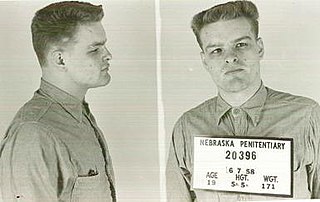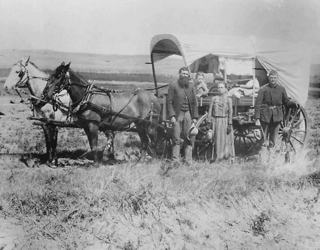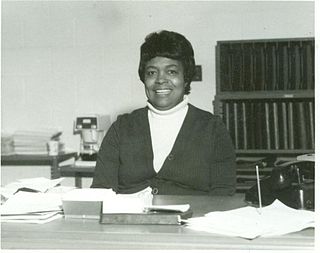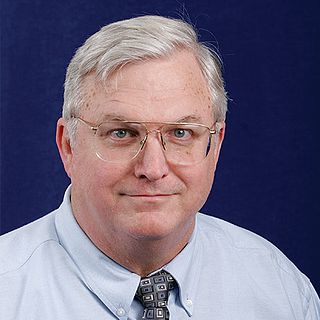Related Research Articles

Lincoln is the capital city of the U.S. state of Nebraska and the county seat of Lancaster County. The city covers 99.050 square miles (256.538 km2) with a population of 292,657 in 2021. It is the second-most populous city in Nebraska and the 73rd-largest in the United States. The city is the economic and cultural anchor of a substantially larger metropolitan area in the southeastern part of the state called the Lincoln Metropolitan and Lincoln-Beatrice Combined Statistical Areas. The statistical area is home to 361,921 people, making it the 104th-largest combined statistical area in the United States.

Charles Raymond Starkweather was an American spree killer who murdered eleven people in Nebraska and Wyoming between December 1957 and January 1958, when he was 19 years old. He killed ten of his victims between January 21 and January 29, 1958, the date of his arrest. During his spree in 1958, Starkweather was accompanied by his 14-year-old girlfriend, Caril Ann Fugate.
Harold Schechter is an American true crime writer who specializes in serial killers. He is a Professor Emeritus at Queens College, City University of New York where he taught classes in American literature and myth criticism for forty-two years. Schechter's essays have appeared in numerous publications including The New York Times, The Wall Street Journal, The Los Angeles Times, and the International Herald Tribune. He is the editor of the Library of America volume, True Crime: An American Anthology. His newest book, published in March 2021, is Maniac: The Bath School Disaster and the Birth of the Modern Mass Killer.

In United States history, the Gilded Age was an era extending roughly from 1870 to 1900. It was a time of rapid economic growth, especially in the Northern and Western United States. As American wages grew much higher than those in Europe, especially for skilled workers, and industrialization demanded an ever-increasing unskilled labor force, the period saw an influx of millions of European immigrants.

Arikara, also known as Sahnish, Arikaree, Ree, or Hundi, are a tribe of Native Americans in North Dakota. Today, they are enrolled with the Mandan and the Hidatsa as the federally recognized tribe known as the Mandan, Hidatsa, and Arikara Nation.

Caril Ann Fugate is the youngest female in United States history to have been tried and convicted of first-degree murder. She was the adolescent girlfriend of spree killer Charles Starkweather, being just 14 years old when his murders took place in 1958. She was convicted as his accomplice and sentenced to life imprisonment, being paroled after 17 years in 1976.

The Nebraska State Capitol is the seat of government for the U.S. state of Nebraska and is located in downtown Lincoln. Designed by New York architect Bertram Grosvenor Goodhue in 1920, it was constructed of Indiana limestone from 1922 to 1932. The capitol houses the primary executive and judicial offices of Nebraska and is home to the Nebraska Legislature—the only unicameral state legislature in the United States.

Wright Marion Morris was an American novelist, photographer, and essayist. He is known for his portrayals of the people and artifacts of the Great Plains in words and pictures, as well as for experimenting with narrative forms.

The Villasur expedition of 1720 was a Spanish military expedition intended to check New France's growing influence on the North American Great Plains, led by Lieutenant-General Pedro de Villasur. Pawnee and Otoe Indians attacked the expedition in Nebraska, killing 36 of the 40 Spaniards, 10 of their Indian allies, and a French guide. The survivors retreated to their base in New Mexico.

Mari Susette Sandoz was a Nebraska novelist, biographer, lecturer, and teacher. She became one of the West's foremost writers, and wrote extensively about pioneer life and the Plains Indians.
The civil rights movement in Omaha, Nebraska, has roots that extend back until at least 1912. With a history of racial tension that starts before the founding of the city, Omaha has been the home of numerous overt efforts related to securing civil rights for African Americans since at least the 1870s.

The Webster Telephone Exchange Building is located in North Omaha, Nebraska. It was designed by the well-known Omaha architect Thomas Rogers Kimball. After the Easter Sunday Tornado of 1913, the building was used as the center of recovery operations. In 1933, American Bell donated the building to the Omaha Urban League.

The history of the U.S. state of Nebraska dates back to its formation as a territory by the Kansas–Nebraska Act, passed by the United States Congress on May 30, 1854. The Nebraska Territory was settled extensively under the Homestead Act of 1862 during the 1860s, and in 1867 was admitted to the Union as the 37th U.S. state. The Plains Indians are the descendants of a long line of succeeding cultures of indigenous peoples in Nebraska who occupied the area for thousands of years before European arrival and continue to do so today.
African Americans in Omaha, Nebraska are central to the development and growth of the 43rd largest city in the United States. The first free black settler in the city arrived in 1854, the year the city was incorporated. In 1894 black residents of Omaha organized the first fair in the United States for African-American exhibitors and attendees. The 2000 US Census recorded 51,910 African Americans as living in Omaha. In the 19th century, the growing city of Omaha attracted ambitious people making new lives, such as Dr. Matthew Ricketts and Silas Robbins. Dr. Ricketts was the first African American to graduate from a Nebraska college or university. Silas Robbins was the first African American to be admitted to the bar in Nebraska. In 1892 Dr. Ricketts was also the first African American to be elected to the Nebraska State Legislature. Ernie Chambers, an African-American barber from North Omaha's 11th District, became the longest serving state senator in Nebraska history in 2005 after serving in the unicameral for more than 35 years.
Poles in Omaha, Nebraska arrived relatively early in the city's history. The first Polish immigrants came in the 1870s, and the community grew past 1000 in the late 1890s. By the 1930s there were 10,000 of Polish descent, and Omaha claimed the largest such community of the Great Plains. According to the 2000 United States Census, Omaha had a total population of 390,112 residents, of whom 18,447 claimed Polish ancestry. The city's Polish community was historically based in several ethnic enclaves throughout South Omaha, including Little Poland and Sheelytown, first dominated by Irish immigrants.

Bertha Calloway was an African-American community activist and historian in North Omaha, Nebraska. The founder of the Negro History Society and the Great Plains Black History Museum, Calloway won awards from several organizations for her activism in the community and Nebraska. "I Love Black History" was the former website for the Bertha W. Calloway Center for the Research and Study of African and African-American History, Art, and Culture and the Great Plains Black History Museum before it.
The Lincoln County Sheriff's Office is a county-level police agency operating in Lincoln County, Nebraska.
The history of Lincoln, Nebraska began with the settlement of the village of Lancaster in 1856. The county of Lancaster was founded in 1859. Prior to settlement from the westward expansion of the United States, Plains Indians, descendants of indigenous peoples who occupied the area for thousands of years lived in and hunted along Salt Creek. Settlers first came to extract salt from the wild salt flats of Salt Creek. Nebraska was granted statehood March 1, 1867. Soon afterwards a commission created by the State was appointed to locate the State Capital on State lands. The village of Lancaster was chosen for the Capital of Nebraska. The village of Lancaster became Lincoln. Lincoln was named after Abraham Lincoln. The first State Capitol was completed in 1868. Lincoln incorporated on April 1, 1869.
The following is a timeline of Lincoln, Nebraska history including significant social, political, cultural, and economic events in the history of Lincoln.

George Robert "Bob" Dekle Sr. is an American lawyer who was an Assistant State Attorney in Florida's Third Judicial Circuit from 1975 through 2005. During this time, he served as lead prosecuting attorney in the 1980 Orlando murder trial of serial killer Ted Bundy, which ultimately delivered the death penalty that was carried out in 1989. Dekle's book on the case, The Last Murder: The Investigation, Prosecution, and Execution of Ted Bundy, was published in 2011.
References
- ↑ Timothy R. Mahoney, "The Great Sheedy Murder Case and the Booster Ethos of the Gilded Age in Lincoln, Nebraska," Nebraska History, Winter 2001, Vol. 82, No. 4.
- ↑ James L. Sellers Memorial Award Information and Recipient List [Usurped!]
- ↑ H. Lefebrve, The Production of Space, trans. Donald Nicholson-Smith (Oxford: Blackwell, 1991); M. de Certeau, The Practice of Everyday Life, trans. Steven Rendell (Berkeley: University of California Press, 1984), 115–30; Victoria Thompson, "'Telling Spatial Stories': Urban Space and Bourgeois Identity in Early Nineteenth Century Paris," Journal of Modern History (Summer 2003), 523–556; Katherine Cocks, Doing the Town: The Rise of Urban Tourism in the United States, 1850–1910 (Berkeley: University of California Press, 2001) (as cited within the site Gilded Age Plains City)
- ↑ Carole L. Palmer, "Thematic Research Collections" in Chapter 24 of A Companion to Digital Humanities, ed. Susan Schreibman, Ray Siemens, John Unsworth. Oxford: Blackwell, 2004.
- ↑ Michael O'Malley and Roy Rosenszweig, "Brave New World or Blind Alley? American History on the World Wide Web," originally published in Journal of American History 84, 1 (June 1997), republished with permission through the Center for History and New Media. Archived 2011-05-23 at the Wayback Machine